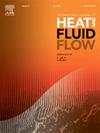Thermo-elastic model and surface evaporation model to Reveal the damage mechanism of melanocytes induced by laser ablation
IF 2.6
3区 工程技术
Q2 ENGINEERING, MECHANICAL
International Journal of Heat and Fluid Flow
Pub Date : 2025-01-30
DOI:10.1016/j.ijheatfluidflow.2025.109763
引用次数: 0
Abstract
This study aims to investigate the interaction between laser irradiation and melanosome particles in Ota’s nevus, as well as to elucidate the thermomechanical damage mechanism of melanin particles. Thermo-elastic and surface evaporation models were employed to simulate the effects of laser ablation on melanin. These models were utilized to analyze the pressure gradient at the melanosome-tissue interface and the formation of vaporization nuclei on melanosome surfaces. Experimental observations were conducted on a tattooed dorsal skin model to examine tissue cavitation and skin whitening. Transient laser heating induced a significant pressure gradient at the melanosome-tissue interface, contributing to mechanical damage. Pulse width exhibited minimal impact on surface evaporation when smaller than the thermal relaxation time of melanosome, while energy density determined the formation of vaporization nuclei. After laser irradiation with an energy density of 4–5 J/cm2, the tissue undergoes vaporization caused by cavitation. Bubble formation resulting from surface vaporization of melanosome explained tissue cavitation and skin whitening. Melanosome particle clusters with smaller spacing exhibited higher peak temperatures and more intense phase transitions, leading to structural damage through rapid bubble expansion. Conversely, larger spacing between melanosome particles resulted in thermal diffusion within cells and overall cell thermal injury. When the particle spacing increased to 0.15 μm, it was observed that the region of microbubble formation in the melanocytes continued to expand, even in the absence of vaporization nuclei formation. Short pulsed laser irradiation effectively treats Ota’s nevus by inducing thermomechanical damage to melanosome particles.
求助全文
约1分钟内获得全文
求助全文
来源期刊

International Journal of Heat and Fluid Flow
工程技术-工程:机械
CiteScore
5.00
自引率
7.70%
发文量
131
审稿时长
33 days
期刊介绍:
The International Journal of Heat and Fluid Flow welcomes high-quality original contributions on experimental, computational, and physical aspects of convective heat transfer and fluid dynamics relevant to engineering or the environment, including multiphase and microscale flows.
Papers reporting the application of these disciplines to design and development, with emphasis on new technological fields, are also welcomed. Some of these new fields include microscale electronic and mechanical systems; medical and biological systems; and thermal and flow control in both the internal and external environment.
 求助内容:
求助内容: 应助结果提醒方式:
应助结果提醒方式:


